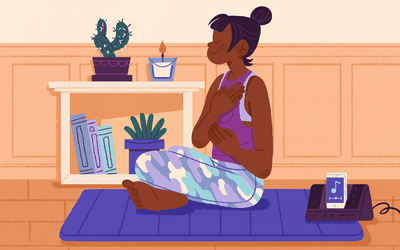
Breathing is a necessary part of existence that most people take for granted. When you breathe in, your blood cells absorb oxygen and expel carbon dioxide. Carbon dioxide is a waste product that is exhaled after being taken back through your body. Improper breathing can disrupt the exchange of oxygen and carbon dioxide, leading to anxiety, panic attacks, exhaustion, and other physical and emotional issues. There are several anxiety breathing exercises to try the next time you feel nervous. Learn how to employ breathing techniques to alleviate anxiety and tension.
Alternate-Nostril Breathing
Alternate-nostril breathing (Nadi shodhana) entails closing one nostril while breathing through the other, alternating between nostrils in a regular sequence.
To preserve your posture, it’s better to practice this form of anxiety-relieving breathing while seated.
Breathing from the belly
The American Institute of Stress recommends 20 to 30 minutes of daily “belly breathing,” also known as abdominal breathing or diaphragmatic breathing, to relieve stress and anxiety.
Find a quiet, comfortable area to sit or lie down. Sit on a chair, cross-legged, or lie on your back with a tiny pillow under your head and another under your legs, for example.
Breathing in a box
Box breathing, also known as four-square breathing, is relatively simple to learn and practice. Indeed, if you’ve ever observed yourself inhaling and exhaling to the beat of the music, you’re already used to this type of timed breathing.
4-7-8 Deep Breathing
The 4-7-8 breathing exercise, often known as the relaxing breath, functions as a natural nervous system sedative. Initially, complete the exercise while seated with your back straight. However, after you’ve mastered this breathing technique, you can do it while resting in bed.
Breath of the Lion
Another beneficial deep breathing practice is lion’s breath, or simhasana in Sanskrit, in which you put out your tongue and roar like a lion. It can help you relax your facial and jaw muscles, relieve stress, and improve your cardiovascular performance. The exercise is best done while seated, bending forward slightly with your hands on your knees or the floor.
Breathing with mindfulness
Focusing on your breathing and directing your attention to the present moment without allowing your mind to wander to the past or future is what mindfulness meditation entails. Mindfulness breathing techniques serve the same goal and can help relieve anxiety. One mindfulness breathing exercise to attempt is to choose a relaxing focus, such as a sound (“om”) or a nice word (“peace”), or a phrase to repeat silently as you inhale or exhale (“breathe in calm, breathe out stress”) Relax and let go. If you sense your thoughts wandering, take a deep breath and gradually bring it back to the present moment.
Pursed-Lip Inhalation
Pursed-lip breathing is a basic breathing technique that will help you take slower, more deliberate deep breaths. This approach has been shown to help those who suffer from anxiety caused by lung illnesses such as emphysema and chronic obstructive pulmonary disease (COPD).
Breathing in Resonance
Resonance breathing, also known as coherent breathing, might help you relax and reduce anxiety.
- Close your eyes and lie down.
- Breathe in slowly via your nose, mouth closed, for six seconds. Don’t overfill your lungs with air.
- Exhale slowly and gently for six seconds, allowing your breath to leave your body slowly and gently.
- Continue for a total of 10 minutes.
- Spend a few minutes being still and concentrating on how your body feels.
Easy Breathing Exercise
This simple breathing technique can be repeated as frequently as necessary. It can be performed while standing, sitting, or lying down. If you find this practice challenging or believe it is causing you anxiety or fear, cease for the time being. Try it again in a day or so, gradually increasing the time.
Slowly and deeply inhale through your nose. Maintain a comfortable posture. Your abdomen should expand, and your chest should only slightly lift.
Slowly exhale through your mouth. Purse your lips slightly as you expel your breath, but keep your jaw relaxed. As you exhale, you may hear a gentle “whooshing” sound.
This breathing technique should be repeated. Repeat for several minutes, or until you begin to feel better.
Anxiety is exacerbated by shallow breathing.
When people are worried, they tend to take fast, shallow breaths from their chests.
This style of breathing, also known as thoracic or chest breathing, disrupts the body’s oxygen and carbon dioxide levels, causing an increase in heart rate, dizziness, muscle tension, and other physical feelings. Your blood is not being oxygenated adequately, which may indicate a stress response that contributes to anxiety and panic episodes.
Diaphragmatic or deep breathing
Diaphragmatic or deep breathing, on the other hand, stimulates the parasympathetic nervous system, a branch of the peripheral nervous system that regulates heartbeat, blood flow, breathing, and digestion.
Abdominal vs. Chest Breathing
Most people aren’t aware of their breathing patterns, yet there are two sorts of breathing patterns:
Diaphragmatic (abdominal) breathing is a sort of deep, even breathing that engages your diaphragm, allowing your lungs to expand and creating negative pressure that forces air in through your nose and mouth, filling your lungs.10 This is how newborn babies breathe normally. When you’re sleeping, you’re probably employing this breathing rhythm as well.
Thoracic (chest) breathing:
This style of breathing originates in the chest and is characterized by short, quick breaths. When you’re stressed, you might not even realize you’re breathing this way.
Put one hand on your upper belly, near your waist, and the other in the middle of your chest to identify your breathing rhythm. Take note of which hand lifts the most while you breathe.
Your abdomen should expand and contract with each breath if you’re breathing properly (and the hand on it should raise the most). It’s especially crucial to be conscious of these distinctions when you’re stressed or anxious, as you’re more likely to breathe from your chest.
